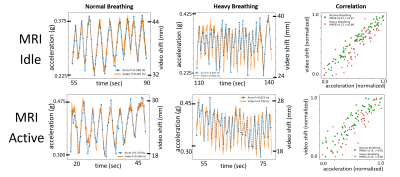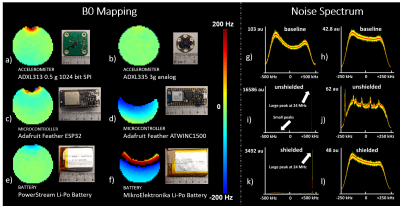Leanna Pancoast1,2, Douglas Brantner1,2, Roy Wiggins1,2, Jerzy Walczyk1,2, and Ryan Brown1,2
1Center for Biomedical Imaging, NYU Grossman School of Medicine, New York City, NY, United States, 2Center for Advanced Imaging Innovation and Research, NYU Grossman School of Medicine, New York City, NY, United States
1Center for Biomedical Imaging, NYU Grossman School of Medicine, New York City, NY, United States, 2Center for Advanced Imaging Innovation and Research, NYU Grossman School of Medicine, New York City, NY, United States
Auxiliary
sensors can help overcome the low temporal resolution in MRI, but often require
cumbersome cabling. We describe an MRI-compatible sensor data acquisition
platform for wireless motion tracking and correlate accelerometer respiratory
motion data with optical measurements.

Figure 4: In vivo respiratory data from the wireless accelerometer (blue) and video (orange) show excellent agreement during normal breathing (~0.25Hz, R>0.9) and lack of interference from MRI through closely matching waveforms and derived respiratory frequencies. The accelerometer and video had slightly lower correlation (R>0.86) during heavy breathing (~0.8Hz), possibly because the respiratory frequency approached the sensor’s current sampling frequency (2 Hz). Note the video (60 fps) was resampled to match the time basis of the accelerometer to display their correlation.

Figure 2: Left panel: Photos alongside frequency maps show devices that are compatible or incompatible with local use because field disturbance is limited (a,b,c,e) or not limited (d,f) to voxels within 2cm of the surface, respectively. Right panel: Noise spectra using the ATWINC1500 show similar characteristics at baseline and with the shielded wireless device for 23.5±0.25MHz, but show interference at 24MHz (likely caused by a harmonic from the 2.4GHz WiFi signal).